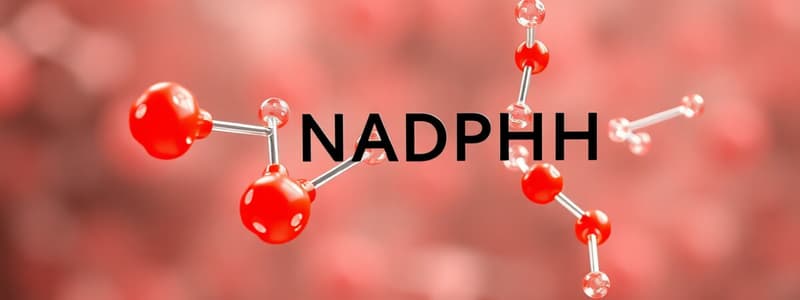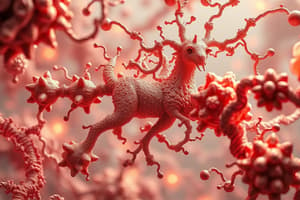Podcast
Questions and Answers
What is the primary role of gluconeogenesis in metabolism?
What is the primary role of gluconeogenesis in metabolism?
- To oxidize glucose to generate energy
- To convert glucose into fatty acids
- To synthesize glucose from lactate and pyruvate (correct)
- To store glucose in the form of glycogen
What energy currency can be produced during the pentose phosphate pathway?
What energy currency can be produced during the pentose phosphate pathway?
- ATP
- NADH (correct)
- FADH
- GTP
Which of the following is NOT a key factor to consider in studying metabolic pathways?
Which of the following is NOT a key factor to consider in studying metabolic pathways?
- Reactants and products
- Cell types involved
- Historical context of pathway discovery (correct)
- Energy balance
In the context of metabolic pathways, what does 'rate limiting step' refer to?
In the context of metabolic pathways, what does 'rate limiting step' refer to?
What is a significant feature of glucose that contributes to its central importance in metabolism?
What is a significant feature of glucose that contributes to its central importance in metabolism?
Which of the following is NOT a pathway for glucose utilization?
Which of the following is NOT a pathway for glucose utilization?
What is the final product of glycolysis?
What is the final product of glycolysis?
Which statement about gluconeogenesis is correct?
Which statement about gluconeogenesis is correct?
What determines the regulation of glycolysis?
What determines the regulation of glycolysis?
Which of the following is a precursor for gluconeogenesis?
Which of the following is a precursor for gluconeogenesis?
Which metabolic process generates NADPH?
Which metabolic process generates NADPH?
What role does hexokinase play in glucose metabolism?
What role does hexokinase play in glucose metabolism?
Which of the following statements about pyruvate is incorrect?
Which of the following statements about pyruvate is incorrect?
What is the primary purpose of the nonoxidative phase of the pentose phosphate pathway?
What is the primary purpose of the nonoxidative phase of the pentose phosphate pathway?
In connection with glucose-6-phosphate dehydrogenase deficiency, which of the following is NOT a known oxidative trigger?
In connection with glucose-6-phosphate dehydrogenase deficiency, which of the following is NOT a known oxidative trigger?
Which pathway is primarily responsible for the synthesis of glucose using various metabolites under non-glucose conditions?
Which pathway is primarily responsible for the synthesis of glucose using various metabolites under non-glucose conditions?
What characteristic differentiates glycolysis from gluconeogenesis?
What characteristic differentiates glycolysis from gluconeogenesis?
Which statement about the pentose phosphate pathway is correct?
Which statement about the pentose phosphate pathway is correct?
What is a primary end product of fatty acid degradation?
What is a primary end product of fatty acid degradation?
In which organ does gluconeogenesis predominantly take place?
In which organ does gluconeogenesis predominantly take place?
Which statement correctly describes the relationship between glycolysis and gluconeogenesis?
Which statement correctly describes the relationship between glycolysis and gluconeogenesis?
How many ATP equivalents are utilized in the conversion of pyruvate to phosphoenol pyruvate?
How many ATP equivalents are utilized in the conversion of pyruvate to phosphoenol pyruvate?
What is required for the activity of pyruvate carboxylase during gluconeogenesis?
What is required for the activity of pyruvate carboxylase during gluconeogenesis?
Which of the following statements about gluconeogenesis is correct?
Which of the following statements about gluconeogenesis is correct?
What happens to oxaloacetate due to mitochondrial membrane impermeability?
What happens to oxaloacetate due to mitochondrial membrane impermeability?
What is the role of phosphoenolpyruvate carboxykinase in gluconeogenesis?
What is the role of phosphoenolpyruvate carboxykinase in gluconeogenesis?
What is the primary purpose of the cori cycle in muscle physiology?
What is the primary purpose of the cori cycle in muscle physiology?
Which product is primarily generated during anaerobic glycolysis?
Which product is primarily generated during anaerobic glycolysis?
What role does NADPH play in the pentose phosphate pathway?
What role does NADPH play in the pentose phosphate pathway?
During lactic acid fermentation in animals, what is the fate of pyruvate?
During lactic acid fermentation in animals, what is the fate of pyruvate?
What is one of the main outcomes of the oxidative phase of the pentose phosphate pathway?
What is one of the main outcomes of the oxidative phase of the pentose phosphate pathway?
Which of the following statements about the pentose phosphate pathway is true?
Which of the following statements about the pentose phosphate pathway is true?
What is the primary regulatory factor for the accumulation of lactate in muscles during vigorous exercise?
What is the primary regulatory factor for the accumulation of lactate in muscles during vigorous exercise?
How does ribulose-5-phosphate contribute to nucleotide synthesis?
How does ribulose-5-phosphate contribute to nucleotide synthesis?
Flashcards are hidden until you start studying
Study Notes
Gluconeogenesis
- Gluconeogenesis synthesizes glucose from smaller sugars and non-carbohydrate sources, essential for glucose-dependent cells during fasting.
- Precursors include pyruvate, lactate, and oxaloacetate from sugars, and glucogenic amino acids from proteins. Fatty acids cannot be converted to glucose.
- Primarily occurs in the liver, while glycolysis mainly happens in muscles and the brain.
- Involves expense of 4 ATP, 2 GTP, and 2 NADH to produce glucose.
- The process allows glucose generation when glycogen stores are low, such as during starvation or intense exercise.
Key Enzymes in Gluconeogenesis
- Pyruvate carboxylase converts pyruvate to oxaloacetate, requiring ATP and acetyl-CoA, and is a major regulatory point.
- Oxaloacetate transported to the cytosol as malate before being converted back for further reactions.
- Phosphoenolpyruvate carboxykinase transforms oxaloacetate into phosphoenolpyruvate using GTP.
Glycolysis Overview
- Glycolysis converts glucose into two pyruvate molecules yielding 4 ATP and 2 NADH while consuming 2 NAD+ and 2 ADP.
- Heavily regulated to match nutrient usage and ATP production needs.
- Key regulatory steps include the activity of hexokinase, phosphofructokinase-1, and fructose 2,6-bisphosphate levels.
Fates of Pyruvate
- Pyruvate can be converted into lactate through fermentation under anaerobic conditions, primarily during intense exercise.
- Lactate can then be transported to the liver to be converted back to glucose via the Cori cycle.
Pentose Phosphate Pathway (PPP)
- The PPP occurs in all cell types, especially the liver; it metabolizes about 30% of glucose for NADPH and ribose-5-phosphate production.
- NADPH is vital for fatty acid synthesis, oxidative damage repair, and cytochrome P450 enzyme function.
- Ribose-5-phosphate is crucial for nucleotide synthesis, essential for DNA and RNA.
- The pathway consists of an oxidative phase generating NADPH and a non-oxidative phase regenerating glucose-6-phosphate from ribose-5-phosphate.
Clinical Correlates
- Glucose-6-Phosphate Dehydrogenase (G6PD) deficiency affects a significant portion of the population, especially in certain regions of Africa.
- Oxidative triggers like infections, specific medications, and foods (like fava beans) can lead to hemolytic anemia in deficient individuals.
Summary of Pathways
- Glycolysis is used to extract energy from glucose under aerobic conditions.
- Fermentation allows continued ATP generation without oxygen.
- Gluconeogenesis uses various metabolites to synthesize glucose and operates in a thermodynamically favorable direction, regulated to avoid futile cycles.
- The pentose phosphate pathway generates vital compounds without utilizing ATP.
Studying That Suits You
Use AI to generate personalized quizzes and flashcards to suit your learning preferences.



